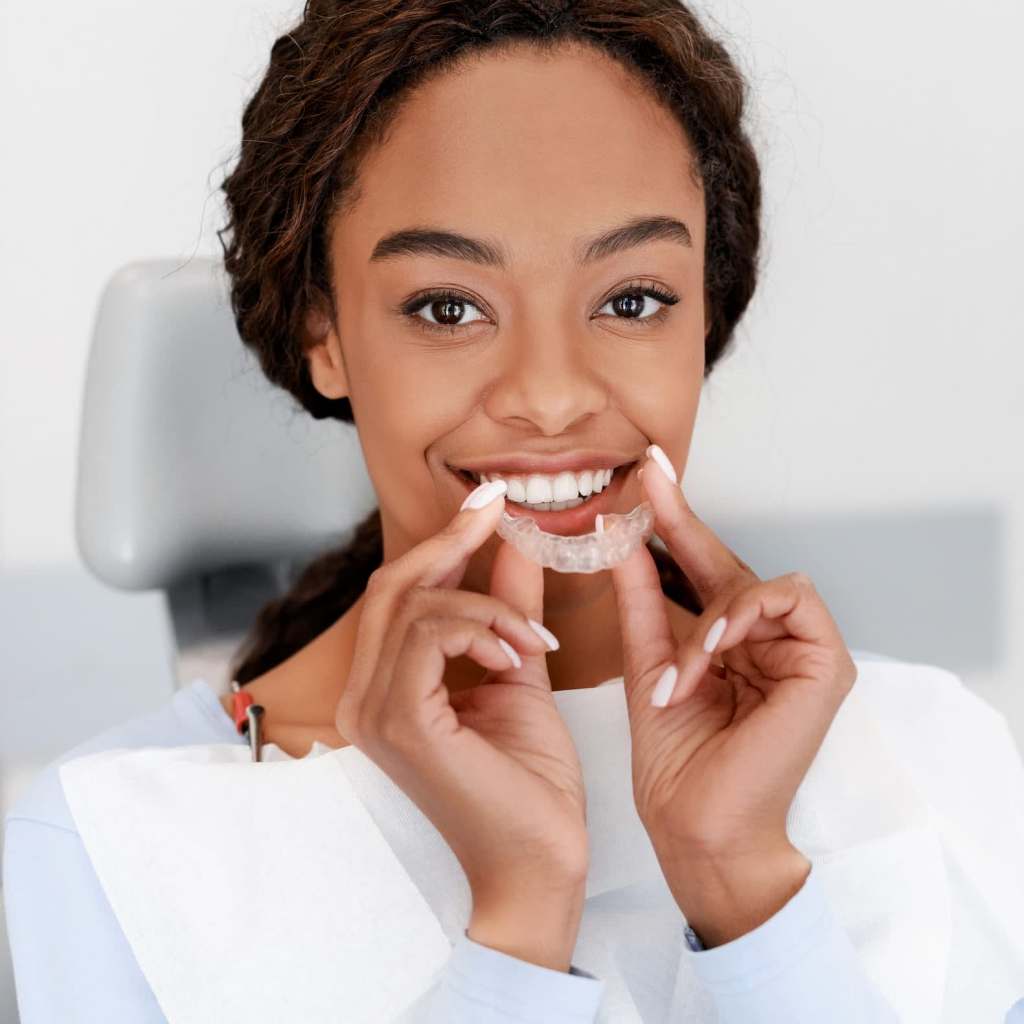If you’re interested in a clear aligner treatment like Invisalign because it’s a discreet and removable alternative to the traditional metal braces you had in high school, you’re not wrong. Those are two very valid pros to the dental treatment.
There’s a lot more to clear aligners than the aesthetics, though, like the importance of wearing them consistently and knowing how to care for them. Plus, there’s the fact that not all clear aligners are created equal – for starters, you’ll definitely want to skip the mail-in options and get them prescribed from an orthodontist instead.
Ahead, we broke down five things you need to know about clear aligner treatments – straight from a board-certified orthodontist.
Clear Aligners Have a Few Advantages Over Metal Braces
While there is the obvious bonus of clear aligners being less noticeable than metal brackets, Raina Chandiramani, DMD, a board-certified orthodontist practicing in Louisville, KY, said the biggest advantage is actually the ease of keeping your teeth healthy and clean – as you can take out the trays to brush and floss your teeth.
“With traditional braces, it is often very difficult for patients to brush and floss their teeth adequately, and therefore hygiene can turn poor, leading to precarious or carious lesions in the teeth,” Dr. Chandiramani said.
Those with bite issues might also benefit from getting this type of treatment, as there are specific instances where clear aligners can fix the problem better than metal braces.
“Specifically, in patients with an open bite, where the top and bottom teeth don’t overlap, clear aligners are often better than metal braces. I offer clear aligner treatment to all of my patients as long as I feel like we can achieve the same or better results as we would with metal braces,” Dr. Chandiramani added.
While Invisalign might immediately come to mind when you think of alternatives to traditional braces, that’s just one brand of clear aligners. “There are many other types of clear aligners, and some orthodontic offices fabricate clear aligners in-house as well.”
You Have to Wear Them Basically All Day
It’s a perk that you can take out the trays to eat, drink, and clean your teeth – but it’s crucial that you put them back in and wear them for the proper amount of time each day.
Dr. Chandiramani said aligners should be worn 20 to 22 hours every day – and should be removed only to eat and brush your teeth. Not doing this is one of the biggest mistakes she sees with aligner therapy.
“People sometimes think that because they don’t wear it through the day and just at night that the trays are fine and still moving the teeth,” Dr. Chandiramani said. “In reality, it takes six hours of light pressure on a tooth to simply initiate the tooth movement process. If a patient only wears the trays while sleeping, this doesn’t leave any time for the teeth to actually move.”
What’s more, a pattern of wearing them for an improper amount of time – where the tooth movement process is initiated and then the light force is removed – isn’t healthy for the teeth.
Dr. Chandiramani said that people often aren’t aware that orthodontists tend to prescribe attachments with clear aligners. “These attachments are tooth-colored buttons bonded to the teeth to give the trays something to grab on to and apply the proper forces in the correct vectors.”
They Should Be Prescribed From Your Orthodontist
With a clear aligner treatment like Invisalign, Dr. Chandiramani explained that orthodontists actually “use their knowledge of tooth movement to predict from the start of treatment how the teeth will move and the necessary forces and pressures to place on the teeth to achieve the desired movements.”
After these specific and expert-approved plans are created, they are then submitted to the software that creates the aligners.
“This is why it is very important to have a skilled doctor planning and supervising treatment,” Dr. Chandiramani added. “There are a lot of DIY tooth movement companies popping up, and these companies do not actually have orthodontists carefully evaluating and supervising clinical cases with the proper records and clinical evaluations. Many people have had terrible results with these companies and end up in orthodontic offices to clean up the mess.”
So if you’re considering aligners, you should always check in with a board-certified dentist or orthodontist for advice.
Cleaning Your Aligners (and Your Teeth!) Properly Is Key
Just like you need to brush retainers, you should clean your aligner trays when you brush your teeth. Dr. Chandiramani recommended using a separate toothbrush and toothpaste to brush the aligners before wearing them.
But because you take out your trays to eat, you’ll need to brush your teeth before putting them back in so that food and bacteria aren’t trapped on the teeth.
“Patients should also never eat or drink anything but water with the trays in,” Dr. Chandiramani urged. “Drinking sodas or juices with the trays in will allow the acidic drinks to sit in the trays and on the teeth and will cause severe decay of the teeth.”
They’re Not For Everyone
Sometimes metal braces can address specific orthodontic cases better than clear aligners – another reason you should always visit an orthodontist for their trained and professional opinion.
“Some examples of these might be impacted teeth, or teeth stuck in the bone, and surgical orthodontic cases,” Dr. Chandiramani said. “In these specific cases, an orthodontist will evaluate the complexity of the case and determine if it will be feasible to complete with clear aligners. There may be a hybrid option of clear aligners with some metal braces or appliances to correct the severe issues.”
Click here for more health and wellness stories, tips, and news.

